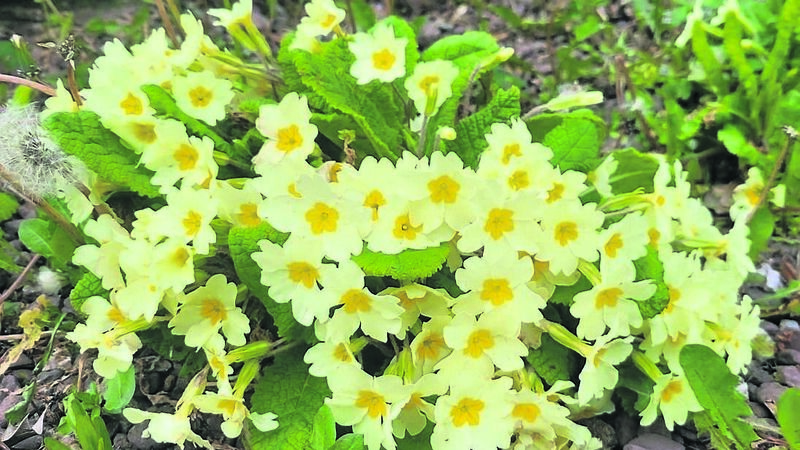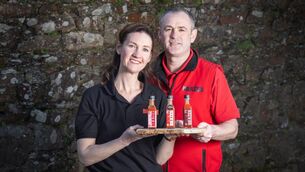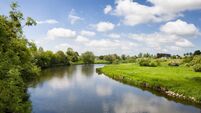In the Garden: My top 10 plants

Primroses might look delicate but they are fierce competitors!
THE countryside is awash with 50 shades of green, as growth gets going and vegetation surges forwards directly out of the soil and from the branches of trees and shrubs.
The canopy is closing in after months of bare branches, and it feels good!
However, it can be a time when weeds seem to take centre stage, and the struggle can be real to keep up with everything going on the garden.
Good ground cover plants are invaluable at this time of year, to grow quickly and smother weeds in those difficult-to-get-to places in the garden, steeper slopes and banks or behind a hedge or building.
Getting plants established that will just spread themselves out, look good, create a worthwhile habitat, and lessen maintenance is what we need.
Here are some of my top 10 if you are looking to create a low maintenance wilder area in the garden that will look good, provide some colour, provide support for the soil, and ingredients for teas and tonics for use in the garden, plus food for various garden visitors - and make your life easier!

1. Comfrey, Symphytum officinale
This is a herbaceous perennial that disappears underground for the winter months, reappearing in the springtime with fresh new oval-shaped leaves that are coarsely hairy. It is a member of the Boraginaceae family and has exceptional properties like deep roots which can access minerals and nutrients deep in the soil. Its leaves are high in nitrogen and potassium, creating a valuable addition to the compost heap. As well as the usefulness of this plant, it has pretty bell-shaped purple, blue or white flowers appearing in springtime and it will establish itself in damp areas quite readily.
2. Alpine or wild strawberry, Fragaria vesca
This appears a delicate little plant yet it has the capacity to spread by means of runners at a pace. When grown in full sun, it will reward you with white flowers followed by tiny tasty red fruits throughout the summer months. Much smaller than commercially grown strawberries but tasty all the same.

3. Greater periwinkle, Vinca major
This has glossy evergreen ovate leaves and is a great plant for banks or slopes where it will establish itself by means of sprawling stems that root at the node when they touch the soil. It will do best in full sun and produce star-shaped blue flowers from spring into summer, often when little else is in flower.
4. Primrose, Primula vulgaris
A common sight on ditches and through hedgerows in spring with its butter yellow flowers. A very competitive plant, it will freely seed itself if given the opportunity and become established in areas of meadow and grass in full sun.
5. Mexican Daisy, Erigeron karviskianus
This produces masses of white daisy flowers throughout the year and also freely self-seeds in cracks and crevices. A native to Mexico and Central America, this plant will tolerate a wide range of soils and growing conditions in its efforts to cover the soil!
6. Japanese spurge, Pachysandra terminalis
A great ground cover perennial native to China and Japan. It has dark evergreen toothed leaves and bears white flowers during summer. It spreads by rhizomes and will establish itself well on shady sloping banks, tolerating a wide range of soils.
7. Bluebell, Hyacinthoides non-scriptus
This is an iconic spring plant. Found commonly in woodland areas, there is a race to flower before the canopy closes in as the leaves unfurl on the deciduous trees, providing a welcome splash of colour on the woodland floor. A bulbous plant, the foliage will die back over the summer, feeding the bulb and providing for next year’s flowers as well as producing seeds that will hybridize and seed themselves freely.
8. Herbaceous geraniums
These create great summer flower displays and plenty of foliage during the growing season to cover the ground and prevent weed establishment. There are a range to choose from and one of the best is Geranium ‘Rozanne’ with its loose foliage and blue flowers that pollinators adore. The flowers are sterile so no dead heading is necessary and the flowers keep on producing into the autumn months. The flowers still produce nectar and pollen, making them a real hit with all kinds of pollinators in the garden.
9. Chinese bramble or Rubus ‘Betty Ashburner’
A prostrate-growing evergreen raspberry that will cloth the soil and produce white flowers in summer followed by small edible raspberries. It spreads by producing shoots that root into the ground and is particularly good on slopes and shaded areas.
10. Creeping thyme, Thymus serpyllum
A soil-hugging herb that bears pink flowers in summer, which are a magnet for bees. It has the added advantage of having aromatic foliage so, when cut or walked on, it will release its sweet fragrance. This plant will do best in full sun on a free draining soil.
Using many of these ten plants will not give the effect of a manicured garden, but they will create a more naturalized look for an area, perhaps requiring less maintenance and giving some valuable habitat in some part of the garden.
It’s much better to have the soil covered and a mat of roots creating some structure also to help to prevent erosion of banks and slopes.
It is May, and if you are considering cutting down on using the lawnmower, then maybe there is a corner of the garden that could be converted to this more relaxed way of gardening, with the gradual introduction of some of these plants.
Happy May Gardening!







 App?
App?


